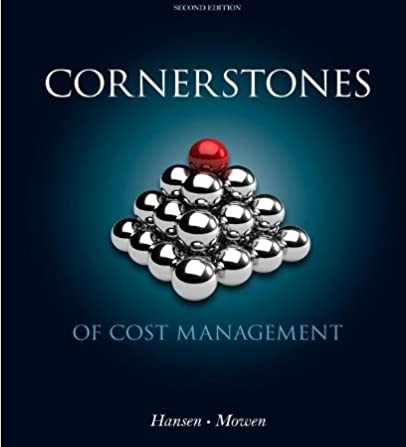
Cornerstones of Cost Management 2nd Edition by Don Hansen ,Maryanne Mowen
Edition 2ISBN: 978-1111824402
Cornerstones of Cost Management 2nd Edition by Don Hansen ,Maryanne Mowen
Edition 2ISBN: 978-1111824402 Exercise 21
Productivity Measurement, Technical and Price Efficiency
In 2012, Fleming Chemicals used the following input combination to produce 55,000 gallons of an industrial solvent:

In 2013, Fleming again planned to produce 55,000 gallons of solvent and was considering two different changes in process, both of which would be able to produce the desired output. The following input combinations are associated with each process change:

The following combination is optimal for an output of 55,000 units. However, this optimal input combination is unknown to Fleming.

The cost of materials is $60 per pound, and the cost of labor is $15 per hour. These input prices hold for 2012 and 2013.
Required:
1. Compute the productivity profiles for each of the following:
a. The actual inputs used in 2012
b. The inputs for each proposed 2013 process change
c. The optimal input combination. Will productivity increase in 2013, regardless of which change is used? Which process change would you recommend based on the prospective productivity profiles?
2. Compute the cost of 2012's productive inefficiency relative to the optimal input combination. Repeat for 2013 proposed input changes. Will productivity improve from 2012 to 2013 for each process change? If so, by how much? Explain. Include in your explanation a discussion of changes in technical and allocative efficiency.
3. Since the optimal input combination is not known by Fleming, suggest a way to measure productivity improvement. Use this method to measure the productivity improvement achieved from 2012 to 2013. How does this measure compare with the productivity improvement measure computed using the optimal input combination?
In 2012, Fleming Chemicals used the following input combination to produce 55,000 gallons of an industrial solvent:

In 2013, Fleming again planned to produce 55,000 gallons of solvent and was considering two different changes in process, both of which would be able to produce the desired output. The following input combinations are associated with each process change:

The following combination is optimal for an output of 55,000 units. However, this optimal input combination is unknown to Fleming.

The cost of materials is $60 per pound, and the cost of labor is $15 per hour. These input prices hold for 2012 and 2013.
Required:
1. Compute the productivity profiles for each of the following:
a. The actual inputs used in 2012
b. The inputs for each proposed 2013 process change
c. The optimal input combination. Will productivity increase in 2013, regardless of which change is used? Which process change would you recommend based on the prospective productivity profiles?
2. Compute the cost of 2012's productive inefficiency relative to the optimal input combination. Repeat for 2013 proposed input changes. Will productivity improve from 2012 to 2013 for each process change? If so, by how much? Explain. Include in your explanation a discussion of changes in technical and allocative efficiency.
3. Since the optimal input combination is not known by Fleming, suggest a way to measure productivity improvement. Use this method to measure the productivity improvement achieved from 2012 to 2013. How does this measure compare with the productivity improvement measure computed using the optimal input combination?
Explanation
1)Calculate the Productivity Profiles:
...
Cornerstones of Cost Management 2nd Edition by Don Hansen ,Maryanne Mowen
Why don’t you like this exercise?
Other Minimum 8 character and maximum 255 character
Character 255


